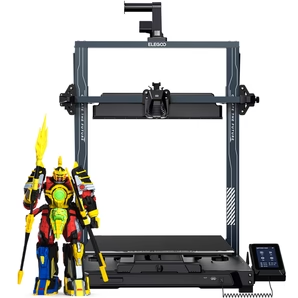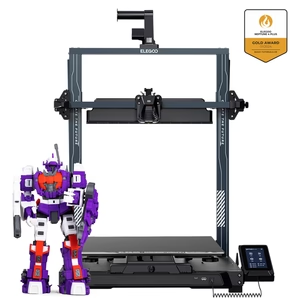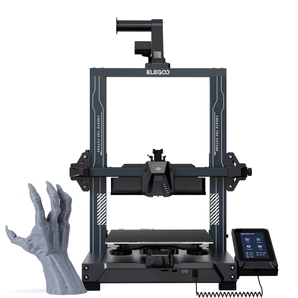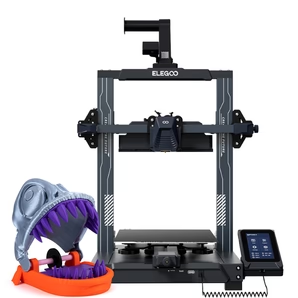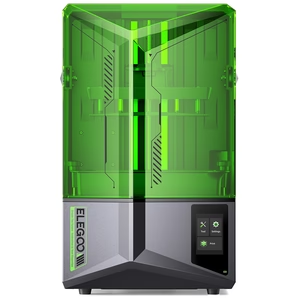Undecided? 3D Resin or Filament Printers?
In the ever-evolving world of 3D printing, two primary technologies have emerged as frontrunners: resin and filament.
Both offer unique advantages and cater to different needs.
But how do you decide which one is right for you?
In this article, we'll dive deep into the differences between resin and filament 3D printers, their pros and cons, and help you make an informed decision.
What is Resin 3D Printing?
Resin 3D printing, also known as SLA (Stereolithography) or DLP (Digital Light Processing), uses liquid resin as its primary material.
The printer cures the resin layer by layer using a light source, solidifying it to form the desired object.
A resin printer like the Elegoo Mars are popular choices among hobbyists and professionals alike.
The primary advantage of resin printing is its ability to produce highly detailed and smooth prints.
However, post-processing can be a bit more involved, as excess resin needs to be washed off, and the print typically requires UV curing.
How Does Filament 3D Printing Work?
Filament 3D printing, commonly known as FDM (Fused Deposition Modeling) or FFF (Fused Filament Fabrication), uses plastic filament as its material. The printer heats the filament and extrudes it layer by layer to build the object.
The other thing about Filament Printers is that they are generally more affordable and easier to use, making them ideal for beginners.
They can also handle a variety of filament blends, from PLA and ABS to more exotic materials like PETG and TPU.
Resin vs. Filament: Which Offers Better Print Quality?
When it comes to print quality, resin 3D printers typically have the upper hand. Thanks to the precision of light processing, resin printers can produce intricate details that might be challenging for filament printers.
However, filament 3D printers, especially high-end models, have come a long way and can also deliver impressive results.
The choice between resin and filament often boils down to the specific requirements of the project and the desired finish.
What About Print Speed and Build Volume?
In terms of print speed, filament printers tend to be faster. Resin printers, while delivering high-quality prints, can be slower due to the layer-by-layer curing process.
As for build volume, filament 3D printers generally offer larger print areas, making them suitable for bigger projects. Resin printers, on the other hand, might have a smaller build volume but are perfect for detailed and smaller objects.
Cost Considerations: Is Resin More Expensive than Filament?
On the surface, filament tends to be more affordable than resin. However, when considering the total cost, including the printer, materials, and post-processing equipment, the difference might not be as significant.
Entry-level filament printers are generally cheaper, but professional FDM printers that support a wider range of materials can be pricey.
On the resin side, while the printers might have a higher initial cost, the price of resin has been decreasing, making it a more viable option for many.
Which is More Versatile: Resin or Filament?
Both resin and filament 3D printers offer versatility in their own right. Filament printers can handle a range of materials, each with its properties, from flexible to sturdy.
Resin printers, while primarily using liquid resin, come with various resin formulations tailored for different applications, from rigid to flexible or even castable resins.
The choice often depends on the specific needs of the project.
Key Takeaways:
- Resin 3D printing uses liquid resin and cures it with light, offering high detail and smooth finishes.
- Filament 3D printing uses plastic filament, extruding it layer by layer, and is generally faster and more affordable.
- While resin printers excel in print quality, filament printers are catching up and offer larger build volumes.
- Cost considerations vary based on the printer, materials, and post-processing needs.
- Both resin and filament 3D printers offer versatility, catering to different project requirements.
- The choice between resin and filament depends on the specific needs, budget, and desired outcomes of the user.
Recommended Printers & Filaments:
- Here's our recommendations for PLA Filaments; and
- For Standard Resin 2.0
Still Need More Info Relating to 3D Printer Fumes?
Check Out Some Common Questions We Recieve:
Difference Between Filament And Resin 3D Printer
» Show Me The Replies
Here are some answers:
- Filament 3D printers use a spool of plastic filament as their raw material, while resin 3D printers use a liquid resin
- Filament printers use a heated extruder to melt and deposit the filament, while resin 3D printers use a laser or UV light to solidify the resin
- Filament prints are typically more durable and flexible, while resin prints are more brittle and rigid
- Filament 3D printers are generally more affordable and easier to use, while resin 3D printers are more expensive and require more specialized knowledge
Resin Vs Filament 3D Printer Strength
» Show Me The Replies
Here are some answers:
- Resin printers are typically stronger than filament printers
- Resin prints have a finer layer resolution which can result in better strength
- Filament printers may have better overall strength for large, solid objects
- Resin prints can be more brittle compared to filament prints
Resin Vs Filament 3D Printer Speed
» Show Me The Replies
Here are some answers:
- Resin 3D printers are generally faster than filament 3D printers
- The speed of a 3D printer depends on several factors, including layer thickness, print size, and model complexity
- Filament 3D printers typically have slower print speeds due to the filament extrusion process
- Resin 3D printers use a photopolymerization process that allows for faster print speeds
3D Printer Resin Vs Filament Cost
» Show Me The Replies
Here are some answers:
- Resin is more expensive than filament
- Resin requires special handling and storage
- Filament can be more cost-effective for large prints
- Filament is easier to find and purchase
Resin Or Filament 3D Printer For Miniatures
» Show Me The Replies
Here are some answers:
- Resin printers produce finer details compared to filament printers
- Filament printers are more affordable and have a wider range of material options
- Resin printers are better for small, intricate details in miniatures
- Filament printers are better for larger, structural pieces



















